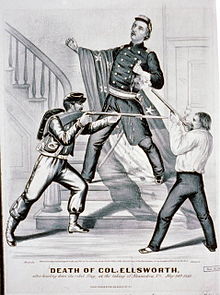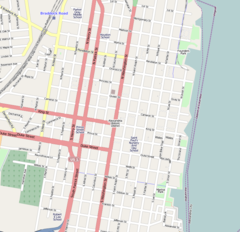
Robert Anderson was a United States Army officer during the American Civil War. He was the Union commander in the first battle of the American Civil War at Fort Sumter in April 1861 when the Confederates bombarded the fort and forced its surrender, starting the war. Anderson was celebrated as a hero in the North and promoted to brigadier general and given command of Union forces in Kentucky. He was removed late in 1861 and reassigned to Rhode Island, before retiring from military service in 1863. In 1865, he returned to Fort Sumter to again raise the American flag that he had lowered during the 1861 surrender.

The Sons of Confederate Veterans (SCV) is an American neo-Confederate nonprofit organization of male descendants of Confederate soldiers that commemorates these ancestors, funds and dedicates monuments to them, and promotes the pseudohistorical Lost Cause ideology and corresponding white supremacy.
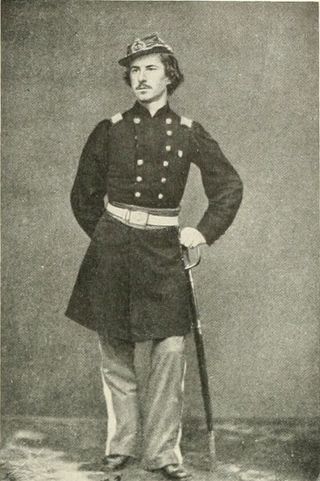
Elmer Ephraim Ellsworth was a United States Army officer and law clerk who was the first conspicuous casualty and the first Union officer to die in the American Civil War. He was killed while removing a Confederate flag from the roof of the Marshall House inn in Alexandria, Virginia.
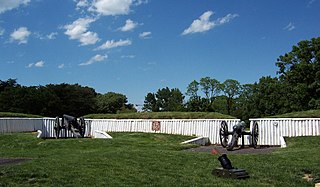
Fort Ward is a former Union Army installation now located in the city of Alexandria in the U.S. state of Virginia. It was the fifth largest fort built to defend Washington, D.C. in the American Civil War. It is currently well-preserved with 90-95% of its earthen walls intact.

Fort Reynolds was a Union Army redoubt built as part of the defenses of Washington, D.C., in the American Civil War.
Commodore Reigert Bolivar Lowry was an officer of the United States Navy.

Fort Jackson was an American Civil War-era fortification in Virginia that defended the southern end of the Long Bridge, near Washington, D.C. Long Bridge connected Washington, D.C. to Northern Virginia and served as a vital transportation artery for the Union Army during the war. Fort Jackson was named for Jackson City, a seedy suburb of Washington that had been established on the south side of the Long Bridge in 1835. It was built in the days immediately following the Union Army's occupation of Northern Virginia in May 1861. The fort was initially armed with four cannon used to protect the bridge, but these were removed after the completion of the Arlington Line, a line of defenses built to the south. After 1862, the fort lacked weapons except for small arms and consisted of a wooden palisade backed by earthworks. Two cannon were restored to the fort in 1864 following the Battle of Fort Stevens. The garrison consisted of a single company of Union soldiers who inspected traffic crossing the bridge and guarded it from potential saboteurs.

Fort Lyon was a timber and earthwork fortification constructed south of Alexandria, Virginia, as part of the defenses of Washington, D.C. during the American Civil War. Built in the weeks following the Union defeat at Bull Run, Fort Lyon was situated on Ballenger's Hill south of Hunting Creek, and Cameron Run, near Mount Eagle. From its position on one of the highest points south of Alexandria, the fort overlooked Telegraph Road, the Columbia Turnpike, the Orange and Alexandria Railroad, the Little River Turnpike, and the southern approaches to the city of Alexandria, the largest settlement in Union-occupied Northern Virginia.
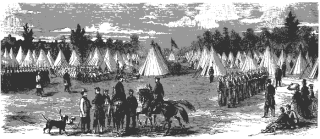
The 11th New York Infantry Regiment was an infantry regiment of the Union Army in the early years of the American Civil War. The regiment was organized in New York City in May 1861 as a Zouave regiment, known for its unusual dress and drill style, by Colonel Elmer E. Ellsworth, a personal friend of U.S. President Abraham Lincoln. Drawn from the ranks of the city's many volunteer fire companies, the unit was known alternately as the Ellsworth Zouaves, First Fire Zouaves, First Regiment New York Zouaves, and U.S. National Guards.

The 44th New York Infantry Regiment was a regiment of the Union Army during the American Civil War which was formed up in mid-1861, and mustered in on August 30, 1861. The regiment wore an americanized zouave uniform which consisted of a dark blue zouave jacket with red piping on the cuffs, dark blue trousers with a red stripe, a red zouave shirt, a dark blue forage cap, and a pair of leather gaiters. The jacket had buttons down the front of it which was not part of the original French zouave uniform.
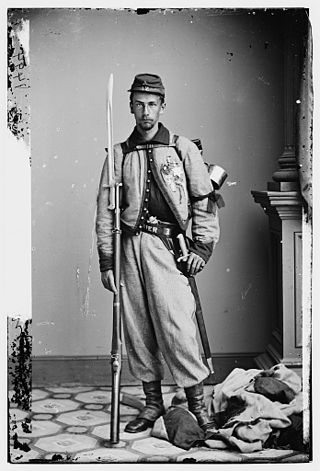
Francis Edwin Brownell was a Union Army soldier who received a Medal of Honor for his actions during the American Civil War. Brownell received the award for killing James W. Jackson after Jackson shot Col. Elmer E. Ellsworth, colonel of the 11th New York Volunteer Infantry Regiment. Although Brownell did not receive the award until 1877, twelve years after the war had ended, his actions were the earliest in the war that resulted in the receipt of the award.
Fort Worth was a timber and earthwork fortification constructed west of Alexandria, Virginia as part of the defenses of Washington, D.C. during the American Civil War.

Fort Ellsworth was a timber and earthwork fortification constructed west of Alexandria, Virginia, as part of the defenses of Washington, D.C. during the American Civil War. Built in the weeks following the Union defeat at Bull Run, Fort Ellsworth was situated on a hill north of Hunting Creek, and Cameron Run,. From its position on one of the highest points west of Alexandria, the fort overlooked the Orange and Alexandria Railroad, the Little River Turnpike, and the southern approaches to the city of Alexandria, the largest settlement in Union-occupied Northern Virginia.

Arlington Ridge is a neighborhood in Arlington County, Virginia. It is bordered on the north by The Pentagon, on the west by the Army Navy Country Club, and on the south the Alexandria. The main thoroughfare is the eponymous Arlington Ridge Road, a mansion-lined boulevard that, due to its high elevation, offers views of Washington, D.C., and the surrounding areas.
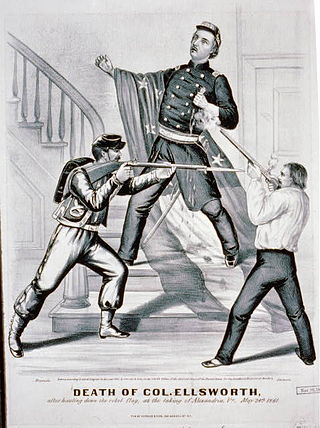
James William Jackson was an ardent secessionist and the proprietor of the Marshall House, an inn located in the city of Alexandria, Virginia, at the beginning of the American Civil War. He is known for flying a large Confederate flag – the "Stars and Bars" variant – atop his inn that was visible to President Abraham Lincoln from Washington, D.C., and for killing Col. Elmer Ellsworth in an incident that marked the first conspicuous casualty and the first killing of a Union officer in the Civil War. Jackson was killed immediately after he killed Ellsworth. While losing their lives, both gained fame as martyrs to their respective causes.
The Battle of Arlington Mills, Virginia, was one of the first military engagements of the American Civil War, a week after the Union occupation of that part of Virginia opposite Washington, D.C. It occurred on June 1, 1861, at about 11:00 p.m., a few hours after the Battle of Fairfax Court House.

The history of Alexandria, Virginia, begins with the first European settlement in 1695. Over the next century, the town became a significant port. In 1801, much of Alexandria was swept into the new District of Columbia; it was damaged along with much of the rest of the capital during the War of 1812. In 1846, Alexandria was returned to Virginia, along with the rest of the District's territory on the western side of the Potomac River. After Virginia seceded in 1861, Alexandria was swiftly captured by Union forces and held for the remainder of the American Civil War. In the late 20th century, Alexandria became a key part of the rapidly growing Northern Virginia region.
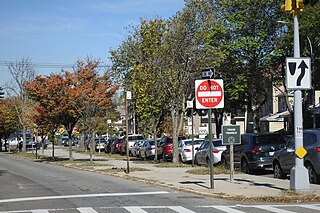
Travis Triangle is a narrow green space in the Murray Hill/Flushing neighborhoods of Queens, New York City. It is formed by the separation of Murray Street and Murray Lane, both of which were named after the Murray family, which owned land on the site of these streets from the late colonial period through the early 19th century. In 1932, New York City's Board of Aldermen passed a resolution to name this site Travis Triangle in honor of local American Civil War veteran Ira Underhill Travis (1839-1921), who fought under the name Ira Wilson, in the 11th New York Volunteer Infantry Regiment also known as Colonel Elmer E. Ellsworth’s Zouaves.

Fort Farnsworth is a former Union Army installation now located in the Huntington area of Fairfax County, Virginia. It was a timber and earthwork fortification constructed south of Alexandria, Virginia as part of the defenses of Washington, D.C. during the American Civil War. Nothing survives of the fort's structure as the Huntington Station of the Washington Metro occupies Fort Farnsworth's former hilltop site.

The United States Zouave Cadets was a short-lived zouave unit of the Illinois militia that has been credited as the force behind the surge in popularity of zouave infantry in the United States and Confederate States in the mid-19th century. The United States Zouave Cadets were formed by Elmer Ellsworth in 1859 from the National Guard Cadets of Chicago, established three years earlier. The unit's 1860 tour of the eastern United States popularized the distinctive zouave appearance and customs, directly and indirectly inspiring the formation of dozens of similar units on the eve of the American Civil War.


